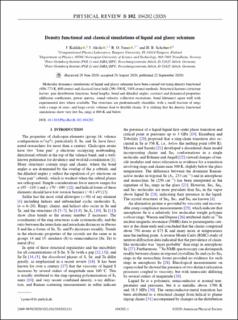Density functional and classical simulations of liquid and glassy selenium
| dc.contributor.author | Kalikka, Janne | |
| dc.contributor.author | Akola, J. | |
| dc.contributor.author | Jones, R. O. | |
| dc.contributor.author | Schober, H.R. | |
| dc.date.accessioned | 2021-09-03T07:33:46Z | |
| dc.date.available | 2021-09-03T07:33:46Z | |
| dc.date.created | 2020-11-09T16:39:08Z | |
| dc.date.issued | 2020 | |
| dc.identifier.citation | Physical review B (PRB). 2020, 102 (10), . | en_US |
| dc.identifier.issn | 2469-9950 | |
| dc.identifier.uri | https://hdl.handle.net/11250/2772728 | |
| dc.description.abstract | Molecular dynamics simulations of liquid and glassy selenium have been carried out using density functional (400–773 K, 600 atoms) and classical force field (290–500 K, 5488 atoms) methods. Structural features (structure factors, pair distribution functions, bond lengths, bond and dihedral angles, cavities) and dynamical properties (diffusion coefficients, power spectra, sound velocity, collective excitations, bond lifetimes) agree well with experimental data where available. The structures are predominantly chainlike, with a small fraction of rings with a range of sizes, and large cavity volumes lead to flexible chains. It is striking that the density functional simulations show very few Se8 rings at 600 K and below. | en_US |
| dc.language.iso | eng | en_US |
| dc.publisher | American Physical Society | en_US |
| dc.title | Density functional and classical simulations of liquid and glassy selenium | en_US |
| dc.type | Peer reviewed | en_US |
| dc.type | Journal article | en_US |
| dc.description.version | publishedVersion | en_US |
| dc.source.pagenumber | 13 | en_US |
| dc.source.volume | 102 | en_US |
| dc.source.journal | Physical review B (PRB) | en_US |
| dc.source.issue | 10 | en_US |
| dc.identifier.doi | 10.1103/PhysRevB.102.104202 | |
| dc.identifier.cristin | 1846311 | |
| cristin.ispublished | true | |
| cristin.fulltext | postprint | |
| cristin.qualitycode | 2 |
Tilhørende fil(er)
Denne innførselen finnes i følgende samling(er)
-
Institutt for fysikk [2654]
-
Publikasjoner fra CRIStin - NTNU [37253]
